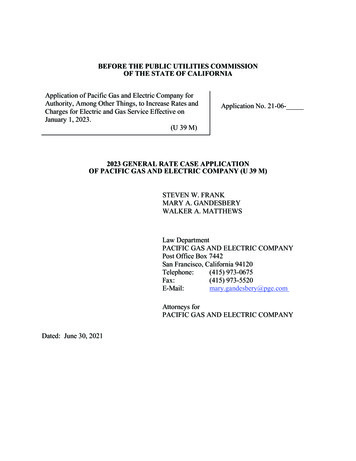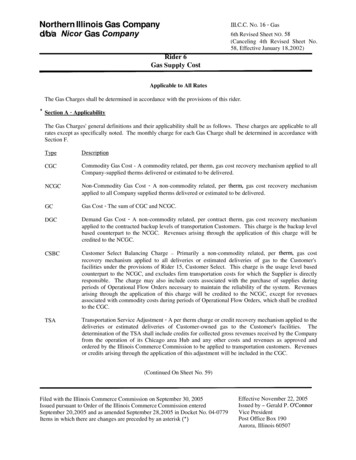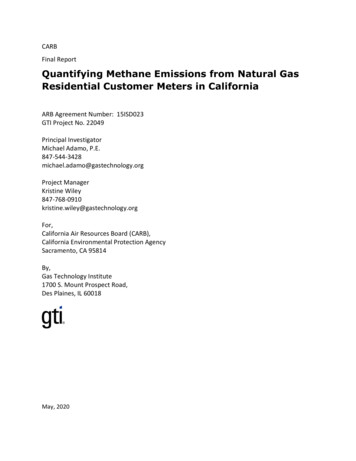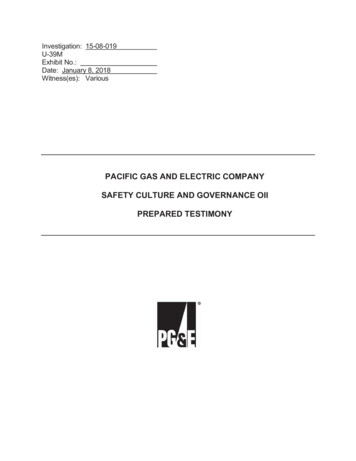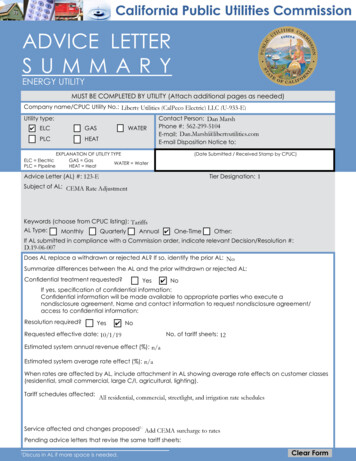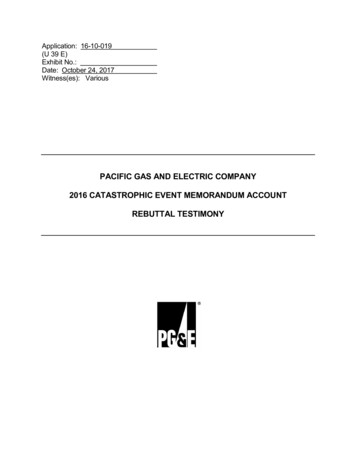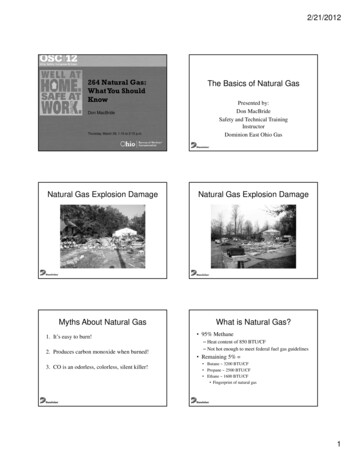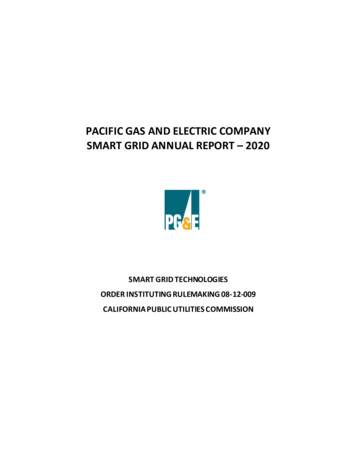
Transcription
PACIFIC GAS AND ELECTRIC COMPANYSMART GRID ANNUAL REPORT – 2020SMART GRID TECHNOLOGIESORDER INSTITUTING RULEMAKING 08-12-009CALIFORNIA PUBLIC UTILITIES COMMISSION
Contents12345Smart Grid Annual Report Executive Summary .21.1 Conclusion .81.2 Epilogue.9Select Smart Grid and Technology Furthering Grid Modernization . 152.1 Wildfire Mitigation & Grid Resilience . 152.1.1Situational Awareness & Forecasting. 152.1.2Grid Design and System Hardening . 172.1.3AM and Inspections . 192.1.4Data Governance & Enablement . 202.2 DER Integration & Enablement . 212.2.1Managing the Effects of DER on the Distribution System . 212.2.2Distribution Resources Planning. 232.3 Customer Service . 242.4 Security . 27Summary of Benefits for Selected Projects . 293.1 Summary of Benefits for Selected Projects. 293.2 Benefits Descriptions . 303.2.1Direct Customer Savings (BFAs/Automated Demand Response(AutoDR)) . 303.2.2Avoided Costs (SmartMeter Outage Information Improvement/MPAC) . 313.2.3Reliability Benefits (FLISR) . 313.2.4Smart Grid’s Role in Furthering Environmental Sustainability . 32Summary Updates for Selected Projects . 344.1 Community Wildfire Safety Program – Select Technologies . 344.2 Customer Engagement and Empowerment Projects. 424.2.1DR Projects. 434.2.2EV Integration Projects . 474.2.3SmartMeter-Enabled Customer Tool Projects . 504.2.4Emerging Customer-Side Technology Projects . 594.3 Distribution Automation and Reliability Projects . 614.4 Transmission Automation and Reliability Projects . 654.5 AM and Operational Efficiency Projects . 684.6 Smart Grid Foundational and Cross-Cutting Technology Projects . 714.7 Customer Outreach & Engagement . 794.8 Smart Grid and Technology Customer Engagement by Initiative Area . 824.9 Security (Physical- and Cyber-) . 844.10 Key Risks Overview . 904.10.1 Key Risks and Actions Taken to Address Them . 914.10.2 Managing Cyber Security Risk Through Control Baseline . 924.10.3 PG&E’s Compliance with NERC Security Rules and Other SecurityGuidelines and Standards as Identified by NIST and Adopted by FERC . 934.10.4 Key Risks Conclusions . 94Smart Grid Metrics and Goals. 965.1 Customer/Advanced Metering Infrastructure Metrics . 965.2 Plug-In Electric Vehicle (PEV) Metric . 102PG&E Smart Grid Annual Report – 2020Page ii
65.3 Energy Storage Metric. 1025.4 Grid Operations Metrics . 103Appendix I . 113PG&E Smart Grid Annual Report – 2020Page iii
CPUC Reporting Requirements andPacific Gas and Electric Company’s Smart Grid Deployment Plan and Project UpdatesPursuant to Decision (D.) 10-06-047, Ordering Paragraph (OP) 15 and the Smart GridDeployment Plan D.13-07-024, OP 4, Pacific Gas and Electric Company (PG&E or the Companyor the Utility) provides this Smart Grid Annual Report (SGAR) with the following informationincluded:a) A summary of PG&E’s deployment of Smart Grid technologies during the reportingperiod (July 2019 through end of June 2020) and its progress on its Smart GridDeployment Plan.1 Added focus is given this year to grid wildfire protection and safetyrelated investments which support the development of the Smart Grid to cope with theaccumulating impacts of climate change 2.b) The costs and benefits of Smart Grid deployment to PG&E’s customers during the pastyear, including a monetary estimate of the health and environmental benefits that mayarise from the Smart Grid where possible 3.c) Current PG&E initiatives for Smart Grid deployments and investments.d) Updates to PG&E’s security risk assessment and privacy threat assessment; and PG&E’scompliance with North American Electric Reliability Corporation (NERC) security rulesand other security guidelines and standards identified by the National Institute ofStandards and Technology (NIST) and adopted by the Federal Energy RegulatoryCommission (FERC).1Unless otherwise specified, PG&E has provided cost and benefits for all projects for the periodbeginning July 1, 2019 through June 30, 2020.2To help meet the climate-driven challenge of increasing wildfires and extreme weather events,PG&E announced a comprehensive Community Wildfire Safety Program (CWSP) in 2018.3For information on project costs and benefits in former years, please reference past Smart GridDeployment Plan Updates on California Public Utilities Commission’s (CPUC or Commission)California Smart Grid website at: www.cpuc.gov/General.aspx?id 4693.PG&E Smart Grid Annual Report – 2020Page i
Consistent with PG&E’s Smart Grid Deployment Plan, PG&E’s SGAR provides information on thestatus of its PG&E’s Smart Grid investments, including Smart Grid Baseline Projects, SmartGrid-Related Customer programs, and proposed Smart Grid Roadmap Projects.44PG&E’s Smart Grid Deployment Plan, A.11-06-029, Chapters 4, 5 and 6.PG&E Smart Grid Annual Report – 2020Page ii
CHAPTER 1SMART GRID ANNUAL REPORTEXECUTIVE SUMMARYPG&E Smart Grid Annual Report – 2020Page 1
1Smart Grid Annual Report Executive SummaryThroughout the reporting period of July 2019 to June 2020, PG&E continued to buildcapabilities to deliver on its vision of modernizing its grid. This vision integrates new energydevices, monitoring and control, and other situational awareness technologies to enablegreater grid safety, resiliency, and energy diversity for our customers. PG&E plays a critical rolein delivering an integrated grid that will help define tomorrow’s energy landscape for California.California has experienced dramatic and rapidly evolving environmental changes 5 in recentyears, resulting in record drought, unprecedented tree mortality, record rainfall, record heatwaves, and extremely strong wind events. The climate change underlying these changes hasaltered the operating risks of the electric grid.6 In the CPUC’s 2018 Fire-Threat Map, more than50 percent of PG&E’s territory is now identified as having an elevated or extreme wildfire risk.PG&E continues to take all efforts necessary to maximize the safety of its electric facilities,including with respect to the risk for catastrophic wildfires. PG&E is providing regular updateson efforts to reduce the wildfire risk via PG&E’s Wildfire Mitigation Plan Report7 and ongoingregulatory and public communications.Grid modernization through Smart Grid and supporting technologies play a key role in PG&E’sstrategies to mitigate risks brought on by the changing climate. PG&E is taking advantage oftechnological advancements to reduce system risks as part of its development of an integratedgrid. These investments play a key role in increasing the flexibility of the grid to allow forgreater resiliency. For example, PG&E is implementing technology demonstration projects andpilot programs to evaluate alternative technologies that may harden and modernize theelectrical system and improve operational capabilities. This includes a demonstration project on5From 2010 to 2018, according to the U.S. Forest Service, over 147 million trees have died inCalifornia. Bark beetle infestations and drought have contributed to this. Moreover, as airtemperatures rise, forests and land are drying out, increasing fire risks and creating weatherconditions that readily facilitate the rapid expansion of fires.6PG&E’s Initial Response to OII and Order to Show Cause (I.19-06-015) filed June 27, 20197PG&E’s 2020 Wildfire Mitigation Plan Report (R.18-10-007) describes the enhanced, accelerated,and new programs that PG&E is and will continue to implement to prevent wildfires in 2019 andbeyond, submitted in February 2019 pursuant to the requirements of SB 901.PG&E Smart Grid Annual Report – 2020Page 2
Rapid Earth Fault Current Limiter (REFCL), a technology that moves the neutral line to thefaulted phase during a fault, significantly reducing the risk of ignition.Microgrids (MG) have the potential to enhance the resiliency of the grid. PG&E is exploring theuse of remote grid configurations as an advanced solution for wildfire risk mitigation. Thisincludes testing the use of MG operations for their potential to reduce customer impact duringproactive grid operations deployed for reducing wildfire risk or other natural disaster responsescenarios. PG&E is actively engaging in new demonstration and pilot projects to help unlocknew value streams provided by Distributed Energy Resources (DERs).An integrated grid enables our customers to have greater flexibility and choice in how they useand obtain value from their energy supply. PG&E customers are leading the adoption of DERsand clean technologies, including solar, storage, and electric vehicles (EV). However, thewidespread adoption of DER and clean technologies also introduces new challenges inoperating the grid, such as those related to two-way power flow, voltage and power qualityissues as well as supply intermittency. Smart Grid and technology advancements help PG&E tomanage and optimize this additional complexity, through advanced grid communication,analysis [monitoring] and control capabilities. This is critical to realizing the requirements setforth in CA’s Senate Bill (SB) 100 (2018), which increases CA’s renewable portfolio standard(RPS) to 60 percent by 2030 and requires all the state’s electricity to come from carbon-freeresources by 2045.8PG&E’s Grid Modernization VisionPG&E’s vision for modernizing its grid through Smart Grid and supporting technologies furthersdevelopments towards a secure, resilient, reliable and affordable platform that strengthens thegrid while enabling continued gains for clean-energy technologies. 9 PG&E’s Smart Grid and8CPUC, RPS Program, https://www.cpuc.ca.gov/rps/.9Adapted from PG&E’s 2020 General Rate Case (GRC) application, Chapter 19, Attachment A: GridModernization Plan – 10 Year VisionPG&E Smart Grid Annual Report – 2020Page 3
technology upgrades are foundational to achieving its grid modernization vision, which focuseson developing the following capabilities:1. Seamless integration of critical grid data visualization, analysis, and control systems tooptimize grid operational efficiency and stability in Real-Time (RT)2. Enhanced situational awareness and operational flexibility to mitigate more dynamicand extreme weather events while minimizing disruption to customers3. Enhanced grid communications and cybersecurity infrastructure necessary to securelyaccommodate the growth in web-enabled grid-tied devices4. Reliable integration of geographically dispersed DER generation and storage optionsto provide customers with clean energy choices and to enable grid configurationsdesigned to provide enhanced resiliency.Figure: PG&E’s Grid Modernization Plan – Integrated Grid CapabilitiesPG&E Smart Grid Annual Report – 2020Page 4
PG&E’s grid modernization vision is, in part, enabled by the Electric Program InvestmentCharge (EPIC). Through EPIC, PG&E has been able to cost-effectively develop and demonstrateinnovative technologies that advance a broad array of objectives including grid safety,resiliency, reliability, and the integration of a wide range of DERs such as clean, renewableenergy. EPIC demonstrations aid in identifying key requirements, implementation challenges,and benefit-cost details to inform future deployment. PG&E’s EPIC projects also support thecreation of new and valuable Intellectual Property (IP), which can lead to improved productsand services that help improve the operations of the electricity grid by reducing operatingexpenses and/or potentially generate alternative forms of incremental revenue that can reducecustomer costs.Given the rapidly evolving energy landscape and the impact of climate change in California, thecontinuation of technology innovation programs like EPIC is critical to the continuedadvancement of the grid. Innovation is further required to enable increased customer choiceand empower Disadvantaged Communities. PG&E is excited to embark on new technologydemonstrations contained within that plan which build on past projects, meet emerging gridneeds and California policy objectives, and ensure that customers and the state can maximizethe benefits of this program.Smart Grid & Technology - Focus Areas:i. Wildfire Safety & Grid Resilience: PG&E details its efforts to reduce the wildfire risk viaPG&E's annual Wildfire Mitigation Plan, including a section on new or emergingtechnologies. Technology plays a significant role in wildfire risk mitigation andassociated potential impact on public safety. Select wildfire mitigation capabilitiesprogressed through smart grid and technology investments include:a. Situational Awareness & Forecasting: PG&E is deploying a powerful set ofcomplementary tools to better assess and more accurately locate, often in nearreal time, environmental events that pose a danger to the grid so that criticalissues may be dealt with as quickly as possible to avoid the risk of catastrophicwildfires. In addition, PG&E is exploring the use of situational awarenesstechnologies and analytics that provide insights on grid conditions. SelectPG&E Smart Grid Annual Report – 2020Page 5
examples include: (i) Incorporating new data sets to further PG&E's WildfireSpread Modelling capabilities; (ii) Promoting situational awareness throughPG&E's industry-leading fire detection system and sharing automated email firealerts with California Department of Forestry and Fire Protection (CAL FIRE) andnumerous county and local fire departments; and (iii) installing sensortechnology on PG&E assets to monitor system health.b. Grid Design & System Hardening: Smart grid and technology investments canenable innovative system hardening techniques to mitigate the risk of fireignition and potential impacts on public safety. Select examples include(i) demonstrating the ability to rapidly reduce the flow of current when faults aredetected to minimize ignition risk; (ii) exploring the use of MG configurations andunderlying technologies to support wildfire risk mitigation; (iii) systemautomation including Supervisory Control and Data Acquisition (SCADA)-enabledrecloser device and sectionalizing device implementation to allow greateroperational flexibilityc. Asset Management (AM) and Inspections: Smart grid and technologyinvestments can enable automated and improved methods to identify asset orsystem issues so that high risk items can be addressed prior to failure. Selectexamples include (i) the development of predictive maintenance tools that canidentify the onset of equipment failure so that correct action can be takenbefore actual failure occurs; and (ii) the use of machine learning and dataanalytics to accelerate accurate inspections to ensure system safety.d. Data Governance & Enablement Smart grid and technology investments unlocknew data streams that can be leveraged to inform risk-based decision-making.PG&E aims to integrate certain data from different data sources into a singleenvironment, enabling data driven approaches to wildfire mitigation initiativesand efforts.Successful wildfire-mitigation-focused technology implementation relies on smart gridtechnology investments, including grid communication tools and control networks, whichPG&E Smart Grid Annual Report – 2020Page 6
enable greater exchange of information required to provide real or near-real timeoperational visibility across the grid for enhanced decision-making. These foundationalitems can also increase the flexibility of the grid, providing additional capabilities to advancesystem resiliency.ii. DER Integration & Enablement: PG&E continues to make significant strides in thedeployment of emerging grid technologies (e.g., solar, grid-tied storage and EV charginginfrastructure) and the deployment of technologies to facilitate integration andoptimization of DER resources. PG&E offers a wide array of incentives to encouragecustomer adoption of cost-effective energy efficiency (EE) measures, is developing newSmart Grid and technology solutions to encourage the adoption of DERs and is exploringthe potential for demand management programs. Some examples of new and emergingSmart Grid and related technologies that seek to optimize DERs for our customersinclude (i) the development of an Advanced Distribution Energy Resources ManagementSystem (ADERMS) and (ii) a demonstration project in collaboration with the CaliforniaEnergy Commission (CEC) and Schatz Energy Research Center to develop a multicustomer MG for enhanced reliability and resilience.iii.Customer Service: PG&E provides customers with the tools necessary to understandand manage their energy use and costs through programs such as Home Energy Reports(HER) and Stream My Data. PG&E also offers innovative programs that help customersparticipate in EE. One example is the introduction of financing programs that reduce theup-front cost of large, comprehensive EE projects that would not have been financiallyfeasible otherwise. Another example is the Residential Pay-for-Performance (P4P) pilotwhich uses the Normalized Meter Energy Consumption (NMEC) approach to estimatecustomer EE savings directly from Advanced Metering Infrastructure (AMI)-meterreadings. PG&E uses market feedback to understand the roadblocks to customeradoption of EE and uses advertising and marketing campaigns to promote engagementwith these tools and participation in programs.iv.Security: The increase in internet-connected Smart Grid and technology devices will beaccompanied by a corresponding increase in cyber-security threats. In December ofPG&E Smart Grid Annual Report – 2020Page 7
2019, the five-year California Energy Systems for the 21st Century (CES-21) programwas concluded. CES-21 was primarily a cybersecurity Research and Development (R&D)partnership among the California investor-owned utilities (IOU) and national labs thatbegan to build the foundation of next generation of industrial control systemscybersecurity and automated threat response capabilities.1.1 ConclusionPG&E’s Smart Grid vision is for a safer, more resilient grid that gives our customers maximumflexibility and maximum choice in how they use energy. Smart Grid and related technologiesplay a key role in achieving this vision. The energy landscape in PG&E service territory isevolving in complexity – a result of climate induced challenges of heightened wildfire threat andincreased DER penetration. Smart grid technologies will have a profound impact on how thegrid operates, enabling new operational processes, providing visibility into RT systemconditions, and increasing grid operating flexibility. This in turn unlocks new capabilities forproactive grid management and opportunities for continuous improvement. PG&E continues toprogress these capabilities through a strategic approach to Smart Grid and technologyinvestments, as highlighted throughout the report.PG&E Smart Grid Annual Report – 2020Page 8
1.2 EpilogueThis year represents the last annual SGAR update pursuant to D.10-06-047 and the Smart GridDeployment Plan D.13-07-024. Substantial progress towards realizing the vision for the SmartGrid has been made in the 10 years since PG&E first submitted its 2011 Smart Grid DeploymentPlan, as highlighted by select examples provided below:1. Smart Grid digital information and control technologies provide a foundation for newgrid devices and capabilities to enhance operational outcomes:a) SCADA technologies have been deployed to most areas of the electrictransmission (ET) and distribution grids. SCADA-enabled reclosing andsectionalizing devices have been implemented at scale to allow greateroperational flexibility and resiliency. Currently, 97 percent of distributionsubstations are equipped with SCADA and nearly 10,000 automated devices(switchers and reclosers) have been installed throughout the distribution system.Nearly 650 additional SCADA commissioned distribution sectionalizers have beeninstalled in Tier 2 and Tier 3 High Fire Threat Districts (HFTD) since 2019 tominimize the impact of Public Safety Power Shutoff (PSPS) events in addition to23 SCADA transmission sectionalizing devices.b) Smart Grid Fault Location, Isolation, and Service Restoration (FLISR) technologyhas so far been installed on 967 of PG&E’s distribution circuits serving2,187,704 customers. To date it has helped PG&E reduce customer powerinterruptions by over one million avoided outage hours over the last five years.c) Line sensors are one of a number of next generation fault identificationtechnologies that monitor and communicate grid disturbances in real time andis being enabled to support preventative maintenance to reduce asset failurerisk. To date PG&E has installed approximately 987 current-measuring linesensors as well as 25 Early Fault Detection (EFD) line sensors across more than350 locations. Since 2019, all line sensors installations (180) have been inHFTD’s, which includes all installed EFD line sensors.PG&E Smart Grid Annual Report – 2020Page 9
d) Development of the next generation of integrated monitoring and controlAdvanced Distribution Management System (ADMS) is underway, which willfurther improve the reliability, security, and efficiency of the electric grid.2. More than 99 percent of customers now have two-way communicating Smart Metersenabling customers to monitor and adjust energy use and providing PG&E with data todrive insights on grid operating conditions:a) Smart Meter technology is the basis for customers being able to monitor andadjust their energy use, including through programs such as StreamMyDatawhich enables real time energy monitoring via a smart phone app.b) PG&E has enabled Single-Phase SmartMeters to send RT alarms to theDistribution Management System (DMS) under partial voltage conditions(25-75 percent of nominal voltage). Energized or de-energized wires down willcreate a low voltage condition on transformers through the mechanism oftransformer back feed from the inactive phase to the fault. This enhancedsituational awareness can help detect and locate downed distribution lines morequickly to enable faster response.c) PG&E is leveraging automated Smart Meter technologies to improve customerservice. These solutions, which include the ability to automatically identify“nested outages”10, have allowed us to realize improved distribution gridreliability, reduced outage restoration times, and provide more accurate outageinformation to our customers. They also can provide data to target maintenanceprograms in the best interest of the customer.3. There has been substantial deployment and integration of cost-effective DERs andrenewable generation:10 A nested outage occurs when a circuit has more than one electrical break occurring in series.PG&E Smart Grid Annual Report – 2020Page 10
a) PG&E’s electricity supply mix has increased from 14.4% eligible renewableenergy in 2009 to 29.7% 11 in 2019, driven by the adoption of solar and otherrenewable energy sources. This has occurred without disrupting grid stability.b) The expansion in grid-tied solar includes 465,000 customer solar systems – morethan 4,400 megawatts (MW) – that were connected to PG&E’s electric grid by2019.c) Battery storage to further integrate clean energy from renewable generationwhile ensuring future grid reliability has been growing rapidly in recent years.Earlier this year, PG&E in partnership with Tesla obtained approval for aone gigawatt (GW) battery storage facility at Moss Landing, which will be one ofthe largest of its kind in the world. Approval for an additional five battery storageprojects totaling 423 MW was requested from the CPUC in May.4. EV Expansions: In 2010, there were 195 customers enrolled in time-variant EV tariffs.Today that number has grown to over 63,000, mirroring the growing adoption of EVs inPG&E’s service area and which reached 292,145 registrations as of June 2020. A pilotprogram is also underway to provide make-ready infrastructure for Level 2 EV chargingstations with a target to reach 4,500 charging ports by 2021. PG&E had installed2,192 ports as of March 31, 2020.5. Energy Efficiency: PG&E’s gross electric energy savings from innovative EE programshave generally exceeded 1,200 gigawatt-hour (GWh) per year between 2011 and 2019,roughly equivalent to the annual energy use of 148,00012 homes.6. Data Driven Insights: Images captured via drone and helicopter are being captured andfed into Sherlock, a web application that allows inspectors to view photographs ofassets along with associated data. The markups from Sherlock feed into computer visionmodels, which are being trained to classify photos, identify asset components, and11 https://www.pgecorp.com/corp responsibility/reports/2020/bu07 renewable energy.html12 Average Pacific states annual residential household electricity use in 2015 was estimated tobe 8,088 kilowatt-hour data/2015/c&e/pdf/ce2.5.pdfPG&E Smart Grid Annual Report – 2020Page 11
search for potential issues in an automated fashion. Models within the inspection floware currently being used to flag select images (e.g. overview, right of way, asset tag),saving time for inspectors and allowing them to focus inspection efforts on potentialignition risks.While the annual reporting of Smart Grid deployments pursuant to D.10-06-047 is coming to anend progress towards California’s vision of a modernized Smart Grid is not. Meeting California’s100 percent clean energy electricity and state-wide carbon neutrality goals by 2045 willcontinue to drive Smart Grid technology change. Two examples that illustrate how PG&E willcontinue to develop and implement the technologies necessary to realize these goals areDistributed Energy Resource Management Systems (DERMS) and data analytics.The increasing penetration of renewables into the grid will bring about significant operationalchallenges in terms of distribution power flow patterns and regulation and necessitate majorchanges to the protection, distribution, automation, as well as voltage and volt-ampere reactivemanagement. Increased renewable generation also implies limited dispatchability andintermittencies, which will require ancillary services. PG&E is developing a DERMS system whichwill provide the advanced monitoring and control capabilities to enable integration of theincreasing adoptions of solar, battery storage, EVs, MGs, etc. while maintaining grid reliabilityand resiliency.Second, the two-way communication channels and data layers being added to the transmissionand distribution (T&D) grids through widespread installation of smart meters and myriadsensors is driving huge growth in RT and near RT data collection. While harnessing such dataoffers new opportunities to operate the grid safely and efficiently, deriving full value from thesedata streams requires advanced data analytics capabilities. PG&E has embarked on developingthese capabilities in a number of key areas, including in the current use of advancedmeteorological forecasting to predict wildfire related outages. Additional use cases beingworked on
a) A summary of PG&E's deployment of Smart Grid technologies during the reporting period (July 2019 through end of June 2020) and its progress on its Smart Grid Deployment Plan.1 Added focus is given this year to grid wildfire protection and safety-related investments which support the development of the Smart Grid to cope with the
